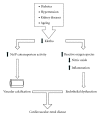The putative role of the antiageing protein klotho in cardiovascular and renal disease
- PMID: 22121479
- PMCID: PMC3205678
- DOI: 10.1155/2012/757469
The putative role of the antiageing protein klotho in cardiovascular and renal disease
Abstract
Ageing is a multifactorial process often characterized by a progressive decline in physiological function(s). Ageing can and is often associated with an increased incidence of cardiovascular and renal disease. Klotho is a novel antiageing gene that encodes a protein with multiple pleiotropic functions including an emerging role in cardiorenal disease. Mice deficient for this gene display a phenotype of premature human ageing characterized by diffuse vascular calcification, altered calcium/phosphate metabolism, and shortened lifespan. Klotho is mainly expressed in the renal tubules but it also exists as circulating soluble form detectable in the blood, with systemic effects. Reduction in soluble Klotho has been associated with renal disease, hyperphosphataemia, increased oxidative stress, endothelial dysfunction, and diffuse vascular calcification. Conversely, overexpression of Klotho promotes cardiovascular-renal protection. The majority of the research on Klotho has been conducted in vitro and in animal studies but there is emerging data from human studies which suggest that Klotho may be a modifiable factor involved in the pathogenesis of cardiovascular and renal disease in at-risk populations. Further data is required to confirm if this novel protein can emerge as therapeutic tool that may be used to prevent or slow progression of cardiorenal disease.
Figures
Similar articles
-
[Klotho not only antiageing protein].Przegl Lek. 2017;74(1):25-9. Przegl Lek. 2017. PMID: 29693998 Review. Polish.
-
The role of the anti-ageing protein Klotho in vascular physiology and pathophysiology.Ageing Res Rev. 2017 May;35:124-146. doi: 10.1016/j.arr.2016.09.001. Epub 2016 Sep 28. Ageing Res Rev. 2017. PMID: 27693241 Review.
-
The Role of Klotho Protein in Chronic Kidney Disease: Studies in Animals and Humans.Curr Protein Pept Sci. 2016;17(8):821-826. doi: 10.2174/1389203717666160526123646. Curr Protein Pept Sci. 2016. PMID: 27226196 Review.
-
FGF23 and Klotho in chronic kidney disease.Curr Opin Nephrol Hypertens. 2013 Jul;22(4):397-404. doi: 10.1097/MNH.0b013e32836213ee. Curr Opin Nephrol Hypertens. 2013. PMID: 23666415 Review.
-
Klotho: a humeral mediator in CSF and plasma that influences longevity and susceptibility to multiple complex disorders, including depression.Transl Psychiatry. 2016 Aug 30;6(8):e876. doi: 10.1038/tp.2016.135. Transl Psychiatry. 2016. PMID: 27576165 Free PMC article. Review.
Cited by
-
Vascular calcification: When should we interfere in chronic kidney disease patients and how?World J Nephrol. 2016 Sep 6;5(5):398-417. doi: 10.5527/wjn.v5.i5.398. World J Nephrol. 2016. PMID: 27648404 Free PMC article. Review.
-
Klotho protein: a new insight into the pathogenesis of essential hypertension.Clin Hypertens. 2024 Dec 1;30(1):36. doi: 10.1186/s40885-024-00294-5. Clin Hypertens. 2024. PMID: 39616409 Free PMC article.
-
Matrix-entrapped cellular secretome rescues diabetes-induced EPC dysfunction and accelerates wound healing in diabetic mice.PLoS One. 2018 Aug 28;13(8):e0202510. doi: 10.1371/journal.pone.0202510. eCollection 2018. PLoS One. 2018. PMID: 30153276 Free PMC article.
-
Age-associated molecular changes in the kidney in aged mice.Oxid Med Cell Longev. 2012;2012:171383. doi: 10.1155/2012/171383. Epub 2012 Dec 30. Oxid Med Cell Longev. 2012. PMID: 23326623 Free PMC article.
-
Regulation of mineral metabolism by lithium.Pflugers Arch. 2014 Mar;466(3):467-75. doi: 10.1007/s00424-013-1340-y. Epub 2013 Sep 7. Pflugers Arch. 2014. PMID: 24013758
References
-
- Kirkwood TBL, Austad SN. Why do we age? Nature. 2000;408(6809):233–238. - PubMed
-
- Quyyumi AA. Endothelial function in health and disease: new insights into the genesis of cardiovascular disease. American Journal of Medicine. 1998;105(1 A) - PubMed
-
- Münzel T, Sinning C, Post F, Warnholtz A, Schulz E. Pathophysiology, diagnosis and prognostic implications of endothelial dysfunction. Annals of Medicine. 2008;40(3):180–196. - PubMed
-
- Lakatta EG. Arterial and cardiac aging: major shareholders in cardiovascular disease enterprises. Part III: cellular and molecular clues to heart and arterial aging. Circulation. 2003;107(3):490–497. - PubMed
-
- Liu Y, Shanahan CM. Signalling pathways and vascular calcification. Frontiers in Bioscience. 2011;16(4):1302–1314. - PubMed
LinkOut - more resources
Full Text Sources
Other Literature Sources


